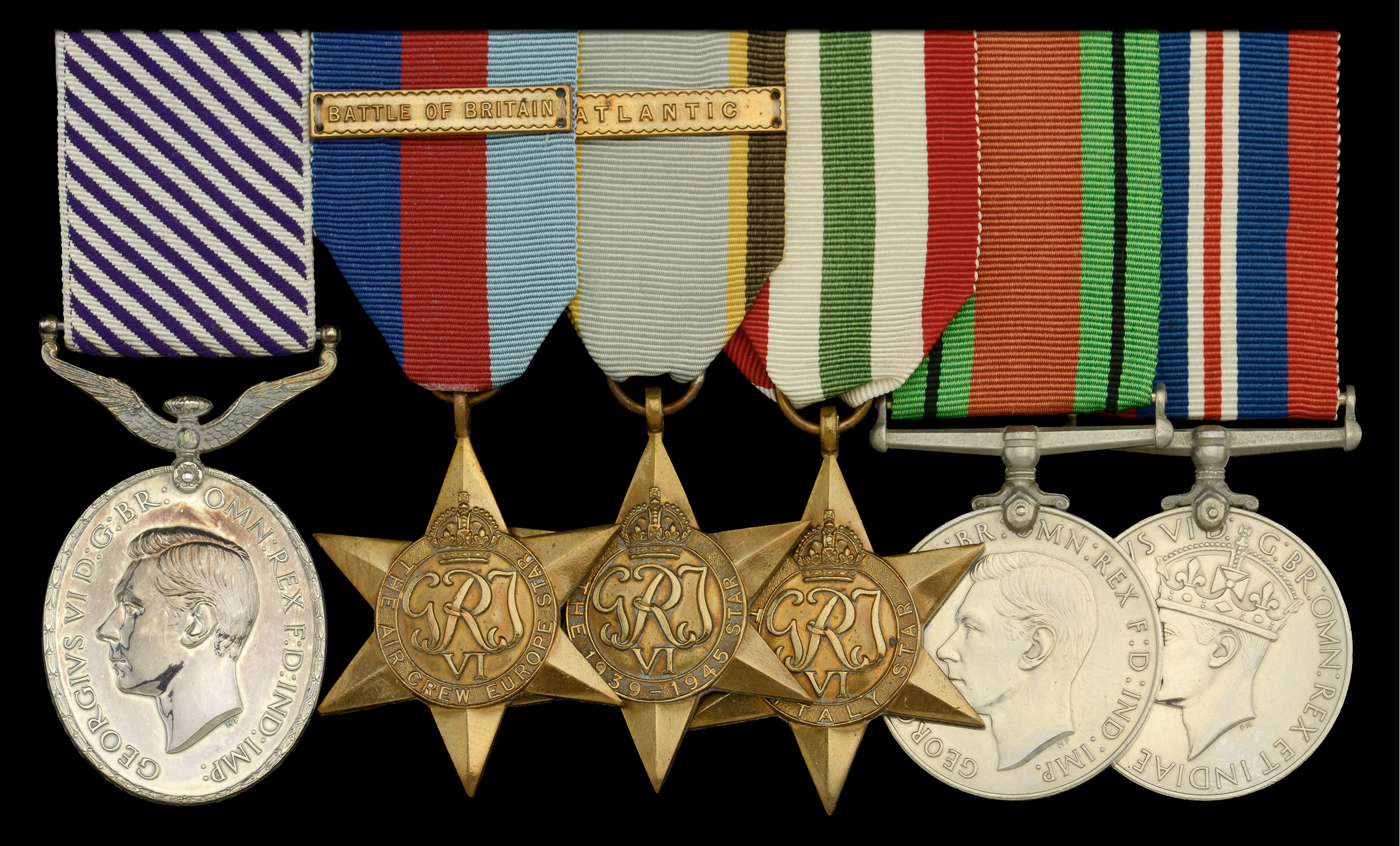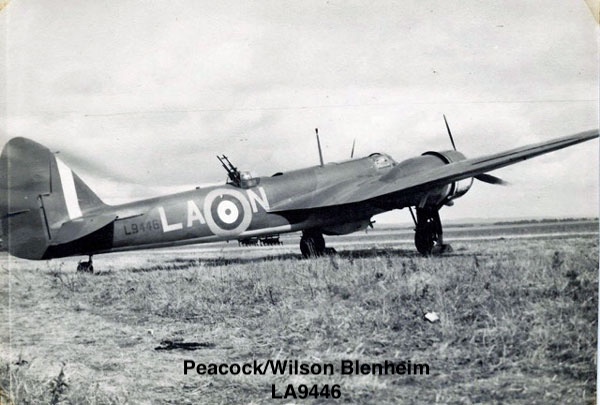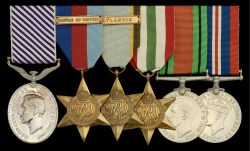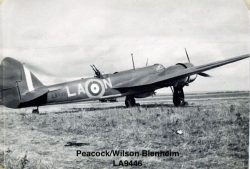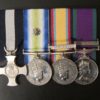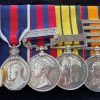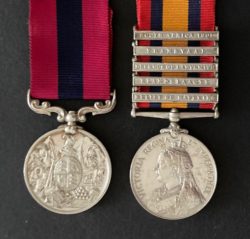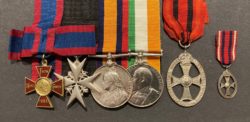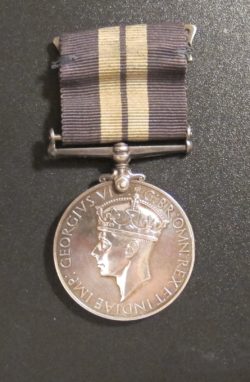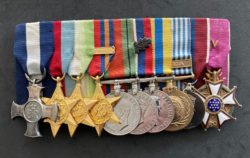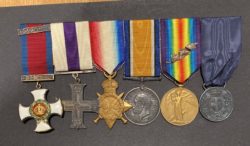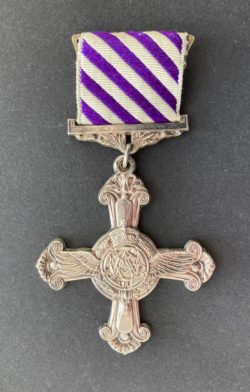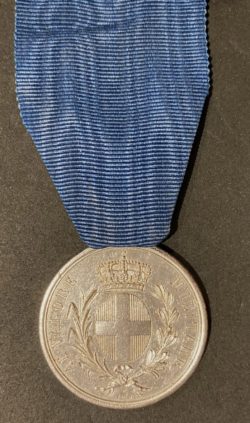1940 Battle of Britain’ D.F.M. group Blenheim fighter wireless operator/air gunner , 235 Squadron, Royal Air Force, who flew with and shared in the victories of his pilot – Squadron Leader R. J. Peacock, whose victories all achieved in 1940 ‘made him Coastal Command’s pilot to ever achieve ‘ace’ status in a Bristol Blenheim Mark IV Fighter’
£10,950.00
Out of stock
Distinguished Flying Medal, (GVI) (Sgt. R.A.F.), 1939-45 Star, clasp, Battle of Britain, Air Crew Europe Star, clasp, Atlantic, Italy Star, Defence Medal, War Medal
W. Wilson
D.F.M. London Gazette 20 October 1940.
The recommendation states:
‘This airman has continually carried out the duties of Wireless Operator/Air Gunner in the aircraft flown by Flying Officer Peacock. He has at all times displayed the greatest coolness and has taken charge of the fire control for the rear gunners of his Section.
It is partly owing to his coolness in withholding fire up to the last second that his Section has been able to compete successfully when attacked by enemy fighters.’
William Wilson joined the Royal Air Force as a Boy Entrant in February 1939 and later as an Airman u/t WOp/AG. After completing his training he joined 235 Squadron (Blenheims) as part of Coastal Command. The Squadron was tasked with fighter-reconnaissance duties, flying out of Detling and Bircham Newton. When the German invasion of the Low Countries began in May 1940, the squadron flew patrols over Holland and during the Battle of Britain was engaged in convoy protection and reconnaissance missions over the North Sea.
Wilson was crewed predominantly with Pilot Officer R. J. ‘Pissy’ Peacock as his pilot, he advanced to Sergeant, and flew numerous patrols over Dunkirk, May – June 1940. Detached to fly from R.A.F. Thorney Island, Wilson was with Peacock and Pilot Officer Wakefield when they flew a reconnaissance of the Zuider Zee, 26/27 June 1940. They were attacked by Me. 109’s, and managed to fight their way back, shooting down one enemy aircraft and shared damaging another in the process.
From ‘Coastal Dawn’ by A. Bird:
‘As June 27 broached its eleventh hour members of A Flight 235 lounged at dispersal in an assortment of chairs and deck chairs. Lancaster and Pardoe-Williams played draughts, as the outside temperature rose and permission was granted to be on standby without tunics…. Just as the remainder of the squadron sat down for lunch in their respective messes they were interrupted by a call from an orderly: “All 235 A Flight aircrew report to operations room immediately”. Everyone dropped their irons and dashed out, arriving breathless. A 16 Group controller was asking for Squadron Leader Clarke. Clarke picked up the receiver and the clipped voice spoke: “Clarke, the British Army request a reconnaissance in the Zuider Zee area. Six aircraft are to take off immediately, this operation is of the utmost importance”…..
Flying Officer Peacock cast an apprehensive look around the room at the nonplussed airmen pulling up a chair. Except for the occasional scrape of clink of a cup, all was quiet. Clarke revealed that the trip would be to Amsterdam then to the southern coast of the Zuider Zee, looking for invasion barges and troop movement… Intelligence told the assembled crews, “if you encounter trouble you should turn south rather than go north where the Luftwaffe has the main concentration of fighters”. Observers unfurled and pored over maps, marking their route in pencil. “Our track would take us right over Schiphol aerodrome where ‘Jerry’ fighters were based”. Pilot Officer Hugh Wakefield takes up the tale: “fitters and riggers had got our charges in tiptop condition. Peacock, my pilot, did his preliminary checks and N3542’s engines roared into life and thus calmed our anxieties.” Clarke boarded N3541, with Pilot Officers Hugh Pardoe-Williams in P6958, Alan Wales in N3543, Peter Weil in P6956, and John Cronan in L9447 consecutively starting up…. With a quick check of the crosswind the six machines pulled off at exactly 13.00 hours… It would be a long and memorable day for Clarke and 235 Squadron.
There was not a cloud in the sky, scarcely a breath of wind on the sea and the heat in the cockpits was almost unbearable…. Maintaining their height at 5,000 feet the six crossed the Dutch coast. On the beach at Zandvoort bathers paused, heads glancing upwards as the six English bomber planes turned northeast towards Amsterdam. The clouds were slight and patchy, the anti-aircraft fire spasmodic and the Blenheims spread out to avoid the shell bursts as they sped over countryside, canals and the Schiphol aerodrome. Wakefield observed: “it is cluttered with German machines, bombers and fighters, some of which appeared to be taking off. Suddenly the ack-ack stopped.” The crews knew what that meant!
Contrary to intelligence it was not from Schiphol but from Rotterdam that the trouble came. Bf109E’s of II./JG54 had moved twenty-four hours earlier and completed two familiarization flights over the local area. The warning sounded at 15.02 local time, “Intercept formation of Blenheim bombers reported near Amsterdam”. Within seconds Austrian born Lt. Jochen Schypeck was airborne with his wingman, soon linking up with the Gruppen-kommadeur of I./JG54 Hubertus Von Bonn, who had taken off from Schiphol. Through the light cloud they quickly spotted the green/brown upper surfaces of the Blenheims despite losing them on occasion as they blended into the countryside. At full throttle they rolled away and dived. Lancaster watched as the fighters came in like a swarm of bees, while fellow observer Wakefield reported:
“The most stunning and frightening moment of my young life when the Bf109E’s shot out of the glorious sparse cloud in a head-on attack. It was a stupendous sight and lasted for two or three minutes as we found ourselves breaking formation and milling around the sky with 109’s as our dancing partners! We knew the Blenheim fighter could turn inside the 109E if we knew precisely when to do it. To this end, we had devised a system for when we were under attack. I moved up from the observer’s position, and opened the port side window behind the pilot, stuck my head out, looking back along the fuselage, and signalled to Peacock with my thumb exactly when and in which direction to turn.”
N3542, having survived a frontal attack, was almost hit a second time from the upper rear port side just south of Schiphol. The 109 closed in to around 400 yards, Wakefield signalled his pilot hard to starboard and the 109 overshot. Peacock automatically turned hard right and got a short burst in as the enemy fighter went away. Peacock made for the nearest cloud.’
The other Blenheims were not so lucky, with Pilot Officer Peter Weil’s aircraft being the first to be shot down. Pardoe-Williams was the next to fall, with Pilot Officer Alan Wales’s aircraft soon after. Pilot Officer John Cronan, a Kiwi, was the pilot of the next Blenheim to fall victim to the German fighters:
‘Peacock had managed to evade the Germans. Observer Wakefield reported:
“After the attack we decided it would be unwise to return the way we had entered, so we flew south to Amsterdam, photographed the harbour with no sign of German naval units, flew along the inner coast of the Zuider Zee and passed Hoorn to Texel where at 14.30 to the southwest we encountered a Henikel 115 seaplane flying at 400 feet. Peacock attacked and only broke off the engagement when all remaining 1,000 rounds were expended. During the first melee and evasive manoeuvres we lost our Perspex canopy and the side and front windows, and so we returned in a somewhat draughty condition to Bircham Newton.”
Peacock was credited with one Bf109E destroyed and another damaged, the latter shared with another pilot. The second machine to make it back to Bircham Newton was the squadron commanding officer Ronnie Clarke, ‘L-London’ N3541.’
Wilson flew multiple Convoy Patrols and Escorts throughout the Battle of Britain. He added to his score with Peacock and Wakefield when they were attacked whilst returning from a reconnaissance escort off the French Coast, 11 August 1940. Once again they shared in the destruction of another Me 109:
‘Yellow air raid warnings at 235’s Hampshire aerodrome during August 11 began as the day started. Vital intelligence was urgently required on the invasion ports of Le Havre and Cherbourg by the Royal Navy. In the dispersal hut Flying Officer Peacock and Pilot Officer Wakefield played darts with Sergeant Wilson. Draped over the battered sofa Sergeant Harold Sutton read the Daily Mail while outside Sergeants Parsons and Newport played draughts and drank mugs of tea….. There was a distinct trill of a telephone and the orderly spoke, “Flying Officer Reginald Peacock – Operations on the telephone”. It was not long before he replaced the receiver, “OK reconnaissance escort, Le Havre, take off twenty minutes”. Olly Wakefield was lead navigator to the section. In daylight the three Blenheim fighters streamed off down the north-south runway and gained height, flying above the cloud base. The R/T was quiet. They had to get the Blenheim in and out of Europe with a minimum of fuss. Wakefield recalled, “The Blenheim bomber went ahead, reduced height over Cherbourg, took photographs then we flew to Le Havre”. The bomber dropped four 250 lb GP bombs on the oil storage tanks at Le Havre, results were not observed but photographs were taken using the hand-held F24 camera.
At the border of enemy territory at 15,000 feet the temperature changed. Chilled air whistled through the fuselage, in the glazed nose Wakefield checked the wind speed and recalculated. Near Fecamp on the return leg Peacock reduced height to 12,000 feet. Immediately shouts of “Fighters” were heard, the pilots tightened their formation. They had fortuitously stumbled into elements of JG2 or JG27 returning from combat on their way home. Automatically Wakefield left the nose and positioned himself behind Peacock. He slid the emergency window open and stuck his head out. They had a busy twenty seconds. Wakefield: “Two Bf109E’s attacked from astern, one was driven off [damaged] and the other was shot down [unconfirmed] by the concentrated fire of our rear gunners Wilson, Newport and Copeland.” (Ibid)
Wilson et al added to their tally when they destroyed a Ju. 88 over Thorney Island, 18 August 1940. They were scrambled as a force of 150 plus aircraft closed in:
‘Stukageschwader 77 was visually first reported by the local Observer Corps near West Wittering who estimated “150 plus aircraft” at 14.23 hours. Less than one mile away across the peninsular on Thorney Island two airmen on an observation post situated on Hangar No. 1 watched heavy black smoke billow into the blue skies inland some distance away using a naval telescope. Whilst airmen and women could scarcely bear to look in land gazing out to sea they were greeted by a vision described as “a swarm of bees” rapidly coming in for the sting.
When the air raid siren began its banshee wail in the surrounding parishes and on the aerodrome, competing with the telephone’s strident jangle their order to scramble came. HQ 16 Group was on the line: “We think there may be some bandits bound for you”. Flying Officer Peacock in L9446, Pilot Officer Wordsworth in N3533 and Flight Sergeant Nelson in N3540 raced across the bumpy grass at full throttle. Wheels up, he was airborne at 14.25. Peacock’s headset crackled “Patrol base”. Climb! Climb! They couldn’t climb any faster. Then, aircraft! On a converging course which would take them directly into the enemy’s path. Oh, God! Masses of them!
Boost was applied and Peacock glanced down to check his safety catch was off. L9446 flew straight for the leader of I Gruppe pack who rolled away, followed by Peacock who closed within 200 yards, pressing his gun button in on the right hand side of the control column. 1,500 rounds were unleashed in seconds, flashes dancing around on the enemy aircraft’s cowling. It burst into flames and dropped into the sea, a white smoke swirl marking the spot.
N3540 ‘Q-Queenie’ downed a second Junkers into the sea (unconfirmed) and Wordsworth in N3533 ‘P-Pip’ fired several well aimed bursts into a third Ju 87, but was hustled out of the way by the greater speed of Hawker Hurricanes of 43 Squadron…. Three dive-bombers slipped through the fighter screen, pouring their lethal loads on to Hangar No. 3 and surrounding buildings… The once tranquil coastal aerodrome had taken on the appearance of a battlefield. Debris showered the area, corrugated metal sliced into the earth or buckled on the concert apron….
Magically the ‘pancake’ instructions came. Back in the circuit, the jubilant trios returned at 14.40 hours, much of the smoke and dust having disappeared. Odd holes were dotted around, which looked as if a mole had burrowed to the surface on the grass… Hangar 3 was wrecked and the station photographic building damaged, with the photographic equipment burnt out and beyond use. Many window panes were broken… Two Blenheims had been destroyed… The interception of the superior force by Hurricanes was crucial to saving the Coastal Command aerodrome. Ably assisted by the station’s ‘local fighting patrol’ flown by Peacock, Wordsworth and Nelson it meant that Thorney Island had sustained relatively little damage…. Flying Officer Reginald Peacock’s claim stood, the Junkers 87 Stuka was his fifth victory, which made him in the annuals of Royal Air Force Coastal Command the first and only pilot to ever achieve ‘ace’ status in a Bristol Blenheim Mark IV Fighter.’
Wilson was recommended for the award of the D.F.M., 26 August 1940, with Peacock being gazetted for the D.F.C. in September of the same year, and Wakefield being gazetted for his D.F.C. at the same time as Wilson.
Wilson continued to fly with the Squadron throughout September – November 1940. His Flight was posted to R.A.F. Aldergrove, 19 November 1940, where it joined a flight from 236 Squadron. Two days later they reformed as 272 Squadron, and Wilson carried out his first operation (still flying with Peacock and Wakefield) with the Squadron on 23 November 1940. They continued to fly on operations together throughout December 1940, before Wakefield was posted to Canada in January 1941, and Peacock was posted for instructional duties at the end of the following month – presumably all tour expired.
